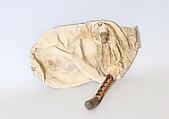Tsambouna
19th century
Not on view
The tsambouna (etymology: συμφωνία, symphony) is a bagpipe found across the Greek islands. This specific tsambouna comes from a village on the island of Naxos. It features a double melodic pipe with five fingerholes on each pipe. The melodic pipes are set in a hand-carved wooden sleeve or yoke, at the end of which an animal horn is fitted, secured to the stock with a piece of string threaded through the horn and the wooden yoke. The wooden insufflation pipe is short and rounded.
The tsambouna is traditionally played across the Greek islands, including the Dodecanese Islands, Islands from the Aegean Sea and Crete (See #89.4.855). It is either accompanied by the drum or the lyra, and is used for celebrations such as weddings, village festivities, and general entertainment. Repertoire includes dance music and songs.
While the overall organology of the tsambouna is shared across the Greek islands, instruments from different islands present differences, in particular regarding the number of fingerholes on the parallel melodic pipe. The island of Karpathos, for example, features a tsambouna with two parallel pipes: one with five finger holes, the other with only one fingerhole. As such the second pipe acts as a two-pitch drone that is used rhythmically and accompanies the main melody. These differences led islands to develop different repertoire, which in turn feed into the uniqueness of each island’s sonic identity. Other differences pertain to the material of the horn: while Naxos favors an animal horn at the end of the melodic pipes, bagpipes from other islands present a monoxyle sleeve ending in a horn, either curved (such as in Karpathos) or straight (Crete).
(Cassandre Balosso-Bardin, 2023)
Technical description
2 cane chanters, 135 mm, with cylindrical bores waxed into wooden yoke, with single horn bell (225 mm including bell);
Fingerholes R 5/0, L 5/0;
Reeds inaccessible (typically, single upcut cane reeds);
Turned insufflation nipple protruding 45 mm outside bag, no evidence of valve, blowpipe tied directly in bag;
Goatskin bag, neck and end tied off inside, pipes in forelegs.
Due to rights restrictions, this image cannot be enlarged, viewed at full screen, or downloaded.
This artwork is meant to be viewed from right to left. Scroll left to view more.



